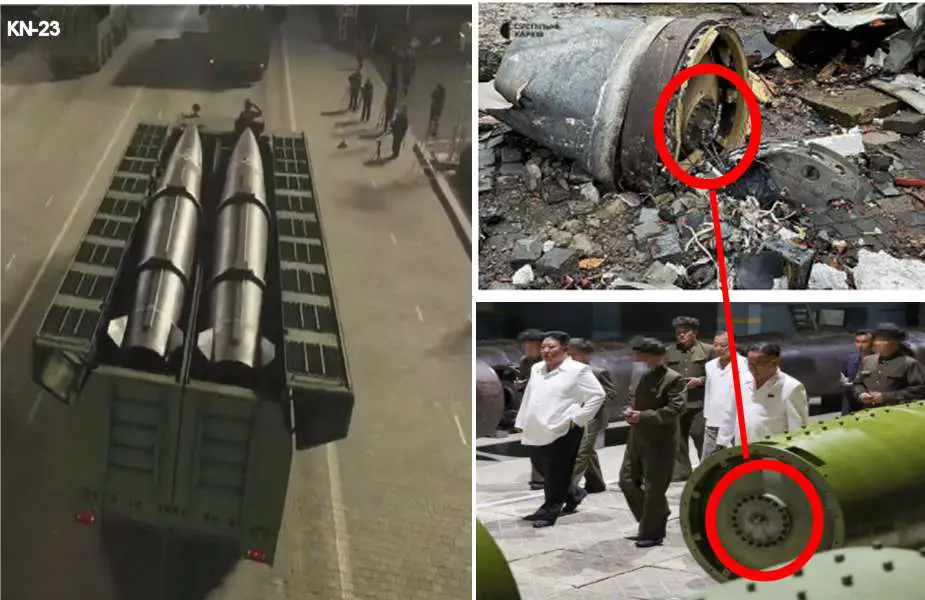- Army
- Conflicts in the world
- Israel - Iran conflict 2025
- Pakistan - India Conflict 2025
- Russia Ukraine War 2022
- Libya conflict day by day
- HAMAS - Israel War 2023
- Operation Serval in Mali French Army
- Sangaris operation Central African Republic
- Sangaris opération militaire République Centreafrique
- Ukraine - Russia conflict
- Syria conflict news
- Defence & Security Industry Technology
- Armies in the world
- Analysis Defense and Security Industry
- Conflicts in the world
- Navy
- Air
US DoD accuses Russia firing North Korean KN-23 ballistic missiles against Ukraine
On January 4, 2024, John Kirby, the spokesperson for National Security at the White House, announced that Russia had used ballistic missiles provided by North Korea against Ukraine. Some open sources have identified these missiles as KN-23s, which were reportedly delivered as noted by the editorial team of Army Recognition on November 26, 2023.
Follow Army Recognition on Google News at this link

North Korean NK-23 ballistic missile was fired by Russia into Ukraine on December 30, 2023, targeting an open field in the Zaporizhzhia region (Picture source: North Korean media and Ukraine social media)
Mr. Kirby revealed that the first of these North Korean missiles was fired by Russia into Ukraine on December 30, 2023, targeting an open field in the Zaporizhzhia region. On January 2, several North Korean ballistic missiles, including the suspected KN-23s, were launched into Ukraine, marking a significant escalation of the Russian offensive.
These North Korean KN-23 ballistic missiles are capable of a range of approximately 550 miles, closely resembling the Russian Iskander-M missile. The Iskander-M has been extensively utilized by Russian forces in the ongoing conflict in Ukraine, raising concerns about the potential impact of North Korea's involvement in the war.
Kirby emphasized that in return, North Korea is seeking Russian military assistance, particularly in fighter jets and ballistic missile technologies, and possibly an increase in collaboration on its nuclear program. Other American officials have reported that North Korea is also seeking more help in enhancing the range and accuracy of its intercontinental ballistic missiles, which it has tested repeatedly in recent months. This North Korean request for increased military aid has significant security implications for the Korean Peninsula and the Indo-Pacific region.
In November 2023, the United States Department of Defense (DoD) reported that North Korea dispatched over 1,000 containers of arms and ammunition, including KN-23 tactical ballistic missiles, to Russia in October 2023. Photographs released by the U.S. showed a large accumulation of these containers at Najin, a North Korean port city near the Russian border. These arms were then reportedly transported across Russia to a location near the Ukrainian border.
Indeed, North Korea and Russia have been discussing increased arms sales since Mr. Kim's visit to Russia in September. Since then, North Korea has shipped hundreds of containers of artillery shells to Russia. However, the impact of these munitions on the battlefield has been limited. Many of the shells, according to Ukrainian and U.S. officials, have been old and performed poorly, with a high dud rate.
While some observers see this as a sign of Russia's desperation to source supplies outside its national territory, others consider that despite Western sanctions, Russia has successfully developed its military production significantly, including cruise missiles, and shorter-range missiles and artillery, since the invasion of Ukraine in February 2022. The North Korean contributions observed in November 2023 by the U.S. would serve to maintain a continuous high rate of fire in the aerial offensive initiated by Russia against Ukraine in early December 2023, which is currently ongoing.
Mr. Kirby explained that the range of the missiles currently being shipped from North Korea allows them to be launched from deep within Russian territory where launch sites are more difficult for Ukraine to target and yet they can still reach several Ukrainian cities.
From a technical point of view, the KN-23 is a North Korean short-range ballistic missile, noted for its distinct features and capabilities. As mentioned above, it is modeled after the Russian Iskander missile system, with a solid-fuel propulsion system that enables quicker launch preparation compared to liquid-fueled missiles. The missile can carry a variety of warheads, including conventional and potentially nuclear ones, making it a versatile weapon in North Korea's arsenal. Its design includes a quasi-ballistic trajectory, allowing the missile to maneuver during flight, making it more difficult to intercept by traditional missile defense systems.
One of the key characteristics of the KN-23 is its range and accuracy. It has an estimated range of approximately 550 miles, which places a significant portion of the Korean Peninsula and parts of Japan within its reach. The missile's guidance system is advanced, providing improved accuracy over older North Korean ballistic missiles. This enhanced precision, combined with its maneuverability and relatively short flight times, poses a significant challenge to regional missile defense systems, increasing the strategic threat posed by North Korea in its regional security context.


























